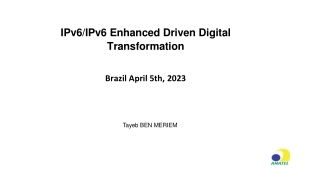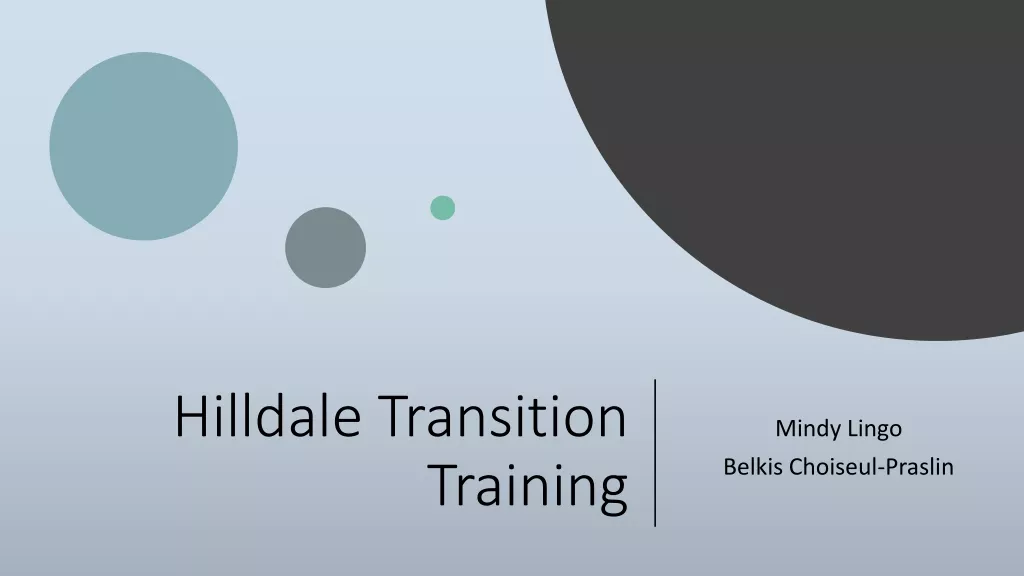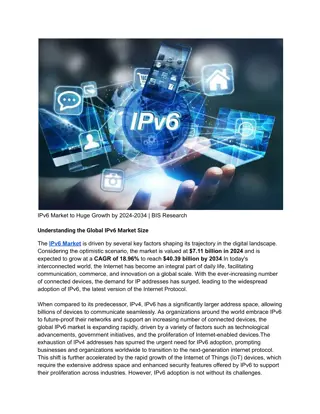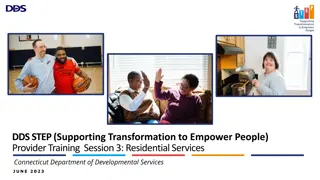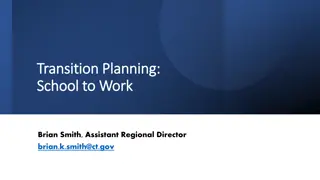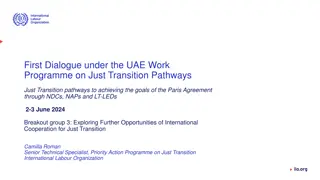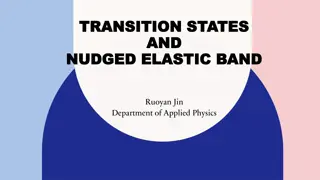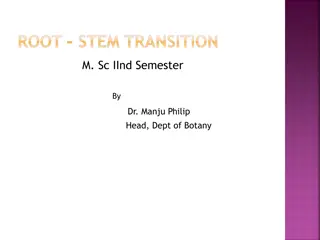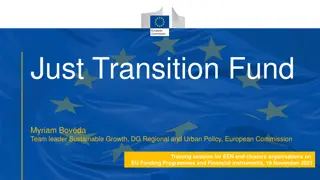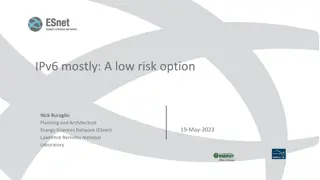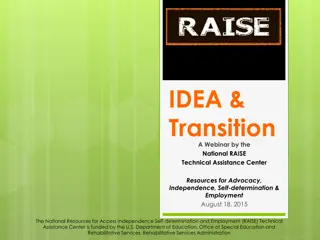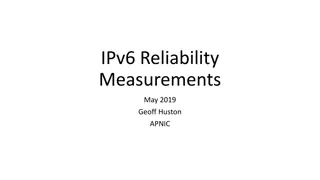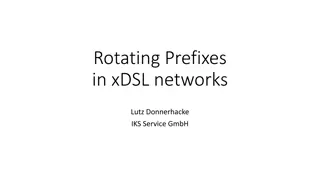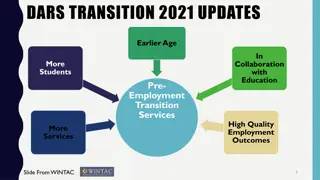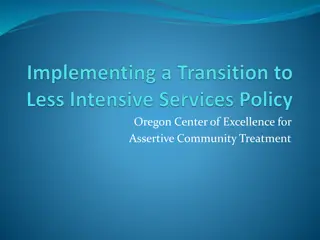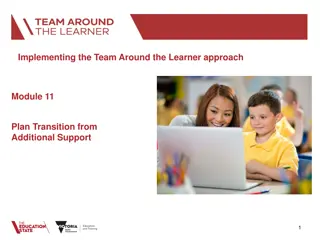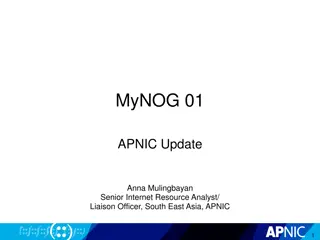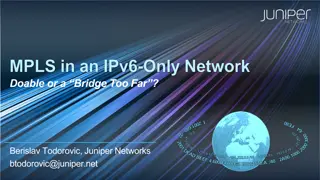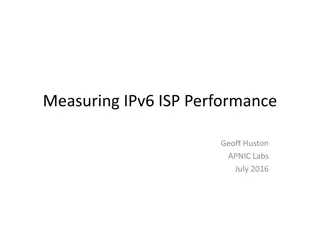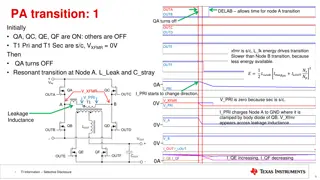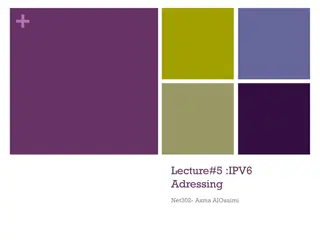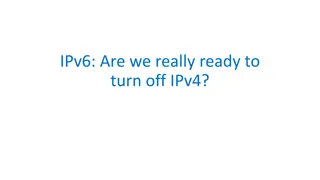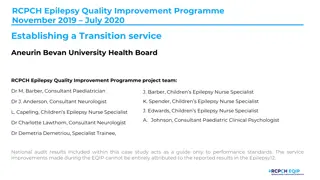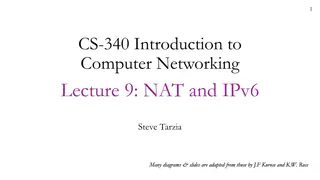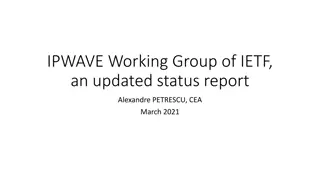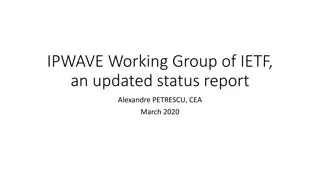IPv6 Enhanced: Key Value for Digital Transformation
Explore how IPv6 plays a crucial role in driving digital transformation, with a focus on policies, societal impact, business opportunities, and stakeholders involved in creating a policy-driven ecosystem for a more inclusive and secure digital society.
0 views • 20 slides
Green Transition Pillar: Shaping the Green Transition Actions
The Green Transition Pillar outlines actions to support Member States in updating national climate adaptation strategies, uptake of climate-proofing guidance, and promoting tools for climate risk assessments. It encourages the use of green budgeting, green public procurement, and disaster resilience
4 views • 9 slides
Understanding Special Education Transition: Goals, Assessments, and Legal Considerations
Exploring the purpose of special education under IDEA 2004, the importance of individualized transition plans, post-secondary goals, the role of transition assessments, and legal implications from case law decisions relating to inadequate transition planning. Key topics include Transition 101, IEP g
8 views • 151 slides
IPv6 Market to Huge Growth by 2024-2034 _ BIS Research
The IPv6 Market is driven by several key factors shaping its trajectory in the digital landscape. Considering the optimistic scenario, the market is valued at $7.11 billion in 2024 and is expected to grow at a CAGR of 18.96% to reach $40.39 billion by 2034.
5 views • 3 slides
Empowering People Through STEP Provider Training
STEP (Supporting Transformation to Empower People) Provider Training Session aims to equip residential service providers with the knowledge and tools to support individuals in their transition towards independence. The training covers topics such as financial incentives, transition planning, and bui
0 views • 20 slides
Transition Planning for School to Work: A Comprehensive Guide
Transition planning is crucial for students moving from school to work life, involving tasks such as connecting with advisors, exploring decision-making options, obtaining necessary identification, and more. The role of the DDS Transition Advisor is pivotal in assisting students, families, and agenc
0 views • 7 slides
International Cooperation for Just Transition in Climate Policies
Explore opportunities for international cooperation in achieving the goals of the Paris Agreement through the integration of Just Transition principles in Nationally Determined Contributions (NDCs), National Adaptation Plans (NAPs), and Long-Term Low-Emission Development Strategies (LT-LEDs). The In
1 views • 7 slides
Understanding Transition States and Nudged Elastic Band in Applied Physics
Description of transition states, potential energy surfaces, saddle points, minimum energy paths, and the Nudged Elastic Band method in the context of applied physics. The content explains key concepts such as transition states along reaction coordinates, the significance of potential energy surface
0 views • 9 slides
Understanding Vascular Transition in Root-Stem Structure
Root and stem in plants form a continuous structure with a transition region between them. The transition involves twisting and inversion of xylem strands, leading to variations in vascular bundles. Eames and Mac Daniels identified different types of vascular transitions in dicots and monocots, each
1 views • 13 slides
EU Just Transition Fund: Supporting Sustainable Growth and Climate Action
The European Commission's Just Transition Fund aims to support regions facing transition challenges by promoting clean energy, sustainable transport, greener industry, nature protection, and a just transition for all. The fund leverages public financing, provides grants, and crowds in private invest
4 views • 16 slides
Understanding IPv6 Addressing and Migration Techniques
IPv6 is designed as the successor to IPv4 due to the depletion of IPv4 address space. This lecture covers topics such as the need for IPv6, IPv4 and IPv6 coexistence techniques like dual-stack, tunneling, and translation, IPv6 addressing using the hexadecimal number system, and IPv6 address represen
0 views • 30 slides
Evolution of Internet Protocol: From IPv4 to IPv6
The evolution of Internet Protocol (IP) from IPv4 to IPv6 has been crucial for adapting to new technologies and addressing specific networking challenges. IPv6 offers a 128-bit address space, improved header format, extensibility, and support for a wide range of services including video, voice, and
0 views • 23 slides
Leveraging IPv6-Mostly: A Low-Risk Option for Network Evolution
IPv6-mostly utilizes DHCP Option 108 to enable devices to operate in an IPv6-only mode, enhancing user experience while reducing risk. By leveraging modern technologies like 464XLAT and CLAT, the transition to IPv6 is seamless, with devices automatically adapting to the available network setup witho
0 views • 13 slides
Enhancing Transition Services for Students with Disabilities
This webinar by the National RAISE Technical Assistance Center delves into the transition requirements of the Individuals with Disabilities Education Act (IDEA). Led by Ron Hager, the session aims to improve adult outcomes for students with disabilities by discussing the principles and tools necessa
0 views • 25 slides
D-Block Elements: Properties and Classification in Chemistry
Welcome to the Department of Chemistry at Kisan Veer Mahavidyalaya, Wai. Explore the Chemistry of Elements of the 3d series, focusing on d-Block Elements and Transition Elements. Learn about their electronic structure, colored ions, magnetic properties, oxidation states, and complex formation. Under
0 views • 34 slides
Insights on IPv6 Reliability Measurements by Geoff Huston at APNIC
Geoff Huston from APNIC conducted IPv6 reliability measurements in May 2019. The study involved comparing IPv4 and IPv6 connections, analyzing TCP connection failures, and highlighting success rates in specific networks like 464XLAT and Reliance JIO in India.
0 views • 29 slides
Understanding Transition Bias and Substitution Models in Genetics
Transition bias and substitution models, explored by Xuhua Xia, delve into the concepts of transitions and transversions in genetic mutations, the causes of transition bias, the ubiquitous nature of transition bias in invertebrate and vertebrate genes, the mitochondrial genetic code, and RNA seconda
1 views • 25 slides
IPv6 Networking Considerations in xDSL Networks
Practical insights and challenges in implementing IPv6 networking in xDSL networks, discussing rotating prefixes, privacy implications, management of multiple prefixes, prefix size considerations, and strategies for DHCP and L2TP termination. The content also covers security measures, prefix rotatio
0 views • 11 slides
DARS Transition Updates 2021: Enhancing Education & Employment Transition Services
Updates from the Department for Aging and Rehabilitative Services (DARS) highlight improved collaboration with educational institutions, leading to better employment outcomes for youth with disabilities. The data reflects increased participation and services provided across different districts, focu
0 views • 11 slides
IPv6 Security and Threats Workshop Summary
David Kelsey from STFC-RAL presented on IPv6 security and threats at the IPv6 workshop pre-GDB at CERN in June 2016. The workshop covered topics such as IPv6 protocol attacks, issues for site network security teams and sys admins, new features of IPv6, security pros and cons, immediate IPv6 concerns
0 views • 29 slides
Understanding IPv6 End Client Measurement Challenges
Adding IPv6 to your website can present risks, potentially impacting client accessibility. Learn about potential issues, measuring end-user behavior without website changes, and using APNIC's web measurement system for insights.
0 views • 27 slides
Transition Planning for Community Treatment Programs
Oregon Center of Excellence for Assertive Community Treatment focuses on transition planning to help individuals move from intensive services to less intensive ones. Research shows that only a small percentage of individuals are ready to transition after being served by ACT for years. Topics covered
0 views • 23 slides
Transition from Additional Support: Module 11 Overview & Plan
Module 11 focuses on planning the transition from additional support for learners and families. It covers recognizing when to plan the transition, developing transition plans, celebrating successes, and following up with the learner and family to ensure continued success. The process involves initia
0 views • 8 slides
Enhancing Secondary Transition Services: Key Strategies for Indicator 13 Implementation
Learn about the essential components of Indicator 13 in secondary transition services, including transition assessment, goal-setting, alignment of IEP goals, and coordination for successful student outcomes. Discover why transition assessment is crucial, how it informs the planning process, and the
0 views • 51 slides
APNIC Internet Resource Analyst Update
Anna Mulingbayan, Senior Internet Resource Analyst and Liaison Officer at APNIC, provides updates on IP address and ASN delegation in the Asia-Pacific region. The content covers IPv4 exhaustion, delegation policies, last /8 delegations, and key policies implemented in 2011. Additionally, it discusse
0 views • 18 slides
Navigating IPv6 and MPLS Challenges for IPv4 Core Edge Transition
Explore the transition solutions and challenges for integrating IPv6 at the edge of an IPv4 core network, including 6PE, 6VPE, MPLS transport options, and the potential for IPv4 elimination. Discover the evolution toward IPv6 adoption in networking standards and the persistent role of MPLS in modern
0 views • 25 slides
Overview of vRouter Implementation in Openstack Neutron
Virtual router (vRouter) is a crucial component in network virtualization, with applications in cloud environments like Openstack Neutron. This article delves into the concept of vRouter, its importance in IPv6 implementations, and the utilization of VM-based vRouters. It also explores the current s
0 views • 12 slides
Understanding IPv6 ISP Performance: A Detailed Analysis by Geoff Huston
This comprehensive study explores the reliability and speed of IPv6 connections, highlighting factors affecting connection failures. It compares datasets from 2011 and 2015/2016, revealing insights on Teredo, 6to4, and unicast address failures. The findings underscore the importance of addressing is
0 views • 37 slides
Understanding Passive/Active Resonant Transition in Power Amplifier
DELAB allows time for node A transition in PA with OUTA and OUTB. The transition is slower than AP transition, making ZVS harder to achieve across load range due to less energy. Transition time is shorter at higher currents, and the controller can adjust delays adaptively. Remember, the conditions f
0 views • 12 slides
IPv6 Addressing and Coexistence: Overview and Challenges
This lecture covers essential topics on IPv6 addressing, including IPv4 issues, the need for IPv6, address representation, types, testing, and verification. It explains how IPv6 is designed to overcome the limitations of IPv4, particularly the depletion of the IPv4 address space. The discussion also
0 views • 44 slides
Evolution of IPv6 Adoption in the Networking Industry
IPv6 adoption has reached 30% globally by the start of 2022. However, progress varies among different sectors, with enterprises lagging behind consumer markets. The slow transition is attributed to market saturation, legacy network issues, and cost considerations. Despite the benefits of IPv6 deploy
0 views • 6 slides
The State of IPv6 Transition: Are We Ready to Turn Off IPv4?
Despite decades of effort, the transition from IPv4 to IPv6 has been slow. Currently stuck in Phase 2, with only a small percentage of Internet users having IPv6 capabilities. New deployments lean towards IPv6 but the majority still rely on IPv4, with gradual migrations to dual-stack for legacy netw
0 views • 49 slides
Establishing Transition Service for Young Epilepsy Patients at Aneurin Bevan University Health Board
The RCPCH Epilepsy Quality Improvement Programme at Aneurin Bevan University Health Board aimed to improve the transition process for young epilepsy patients. The project team implemented the Ready, Steady, Go model to educate teenagers about managing their condition independently. Changes included
0 views • 15 slides
Understanding IP Addresses and Their Classification
IP Addresses, short for Internet Protocol addresses, are unique identifiers assigned to devices on a network. They can be IPv4 or IPv6, with IPv4 having 32 bits and IPv6 being 128 bits. IP addresses are classified into classes A, B, and C, each with specific range and usage. Understanding IP address
0 views • 14 slides
IPv6 Public Policy Considerations - Addressing the Global IP Address Shortage
In light of the global shortage of IPv4 addresses, there is a pressing need for a fair policy for the allocation of remaining addresses. The rapid growth of the Internet has further increased demand for IP addresses, with IPv4 expected to run out soon. The deployment of IPv6 has become a critical is
0 views • 23 slides
Comprehensive Review of IP Address Management Software at Shiraz University
IP Address Management (IPAM) is crucial for registering, tracking, and managing IPs efficiently. This open-source software integrates DNS and DHCP, aiding in growth strategies and transitioning to IPv6. By centralizing information, IPAM addresses challenges like IPv4 exhaustion, conflicting IPs, and
0 views • 26 slides
Understanding NAT and IPv6 in Computer Networking
This lecture covers Network Address Translation (NAT) and IPv6 basics in computer networking. It explains how NAT helps in connecting multiple devices to the internet with limited IPv4 addresses, the concept of public and private IP addresses, and the transition to IPv6 for addressing constraints. V
1 views • 31 slides
IPWAVE Working Group of IETF: Updated Status Report March 2021
The IPWAVE Working Group at IETF focuses on IP wireless access in vehicular environments, working on V2V and V2I use cases. They are currently emphasizing IPv6 over 802.11-OCB networks, with advancements towards higher bandwidth OCB implementations. The group's main work item involves running an IP
0 views • 10 slides
IPWAVE Working Group of IETF - Status Report March 2020
IPWAVE Working Group of IETF focuses on IP Wireless Access in Vehicular Environments, addressing V2V and V2I use cases. Key items include IPv6 over 802.11-OCB and Problem Statement and Use Cases perspectives. The group collaborates with ISO, SAE, ETSI, and IEEE. Major achievements include RFC 8691 p
0 views • 9 slides
Update on IEEE P802.15 Working Group for Wireless Personal Area Networks (WPANs)
The document provides an overview of the recent activities and upcoming events related to the IEEE P802.15 Working Group for Wireless Personal Area Networks (WPANs), including reports on past IETF meetings and details about the agenda for the upcoming IETF 120 in Vancouver. It describes the working
0 views • 17 slides
